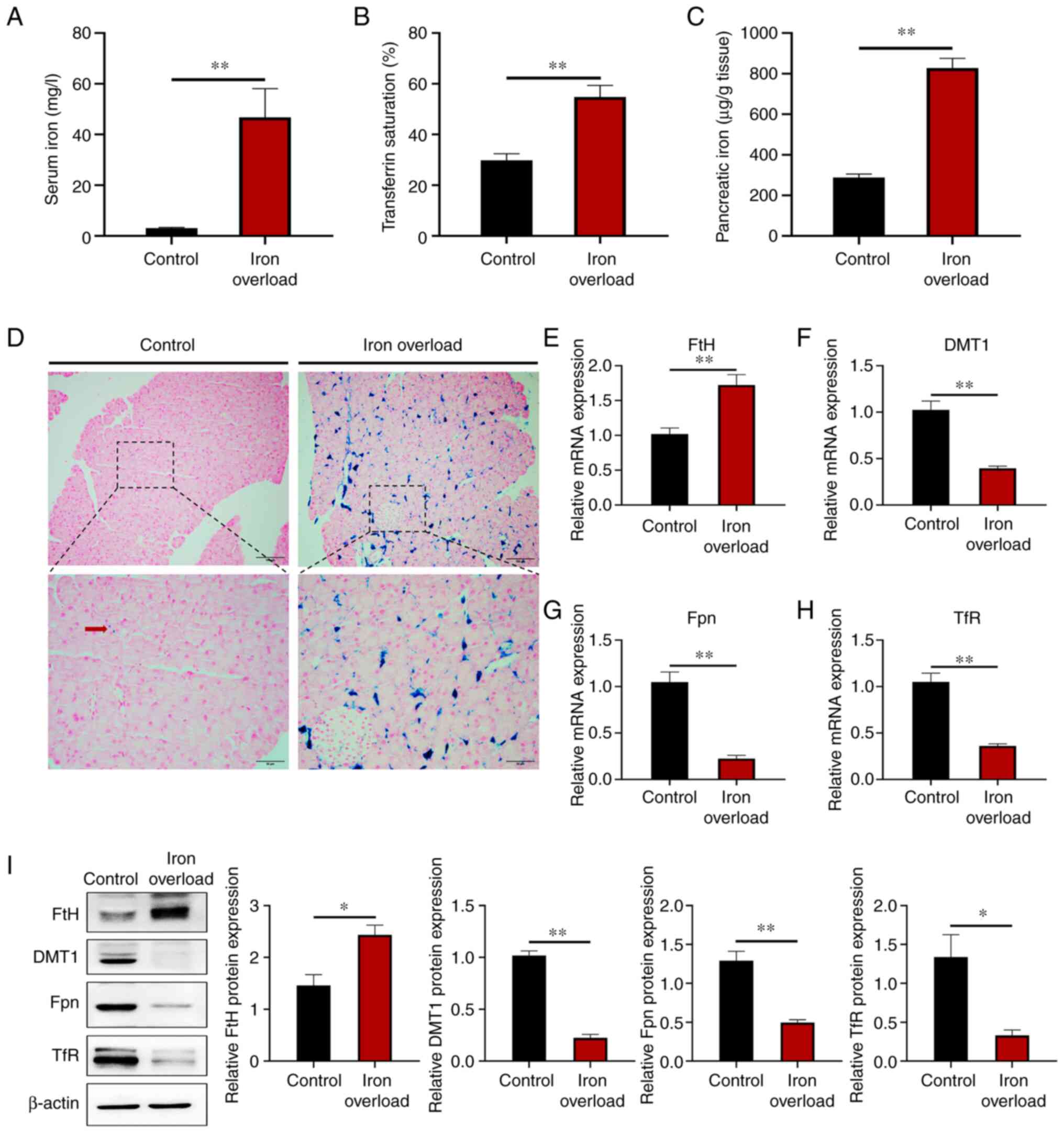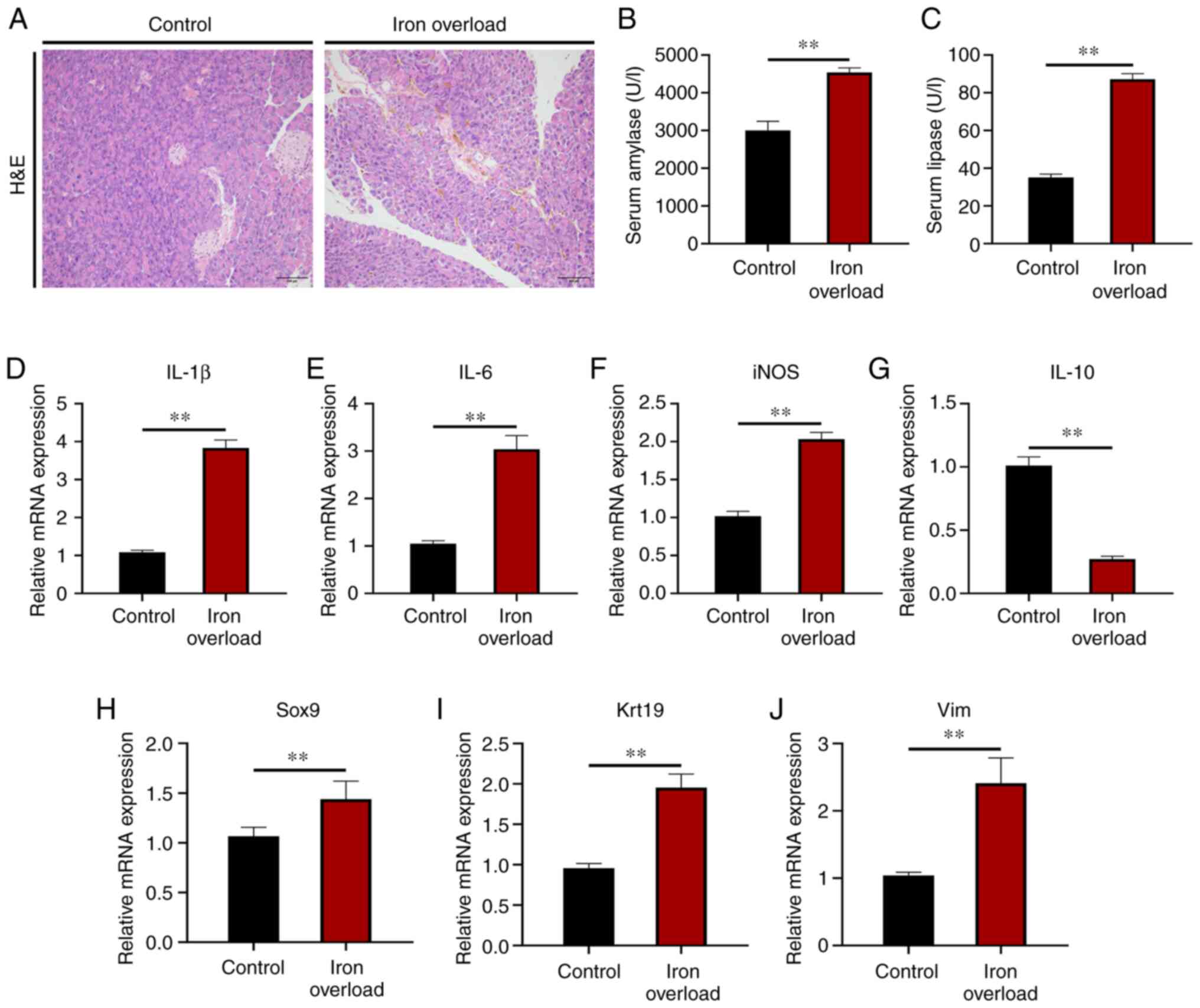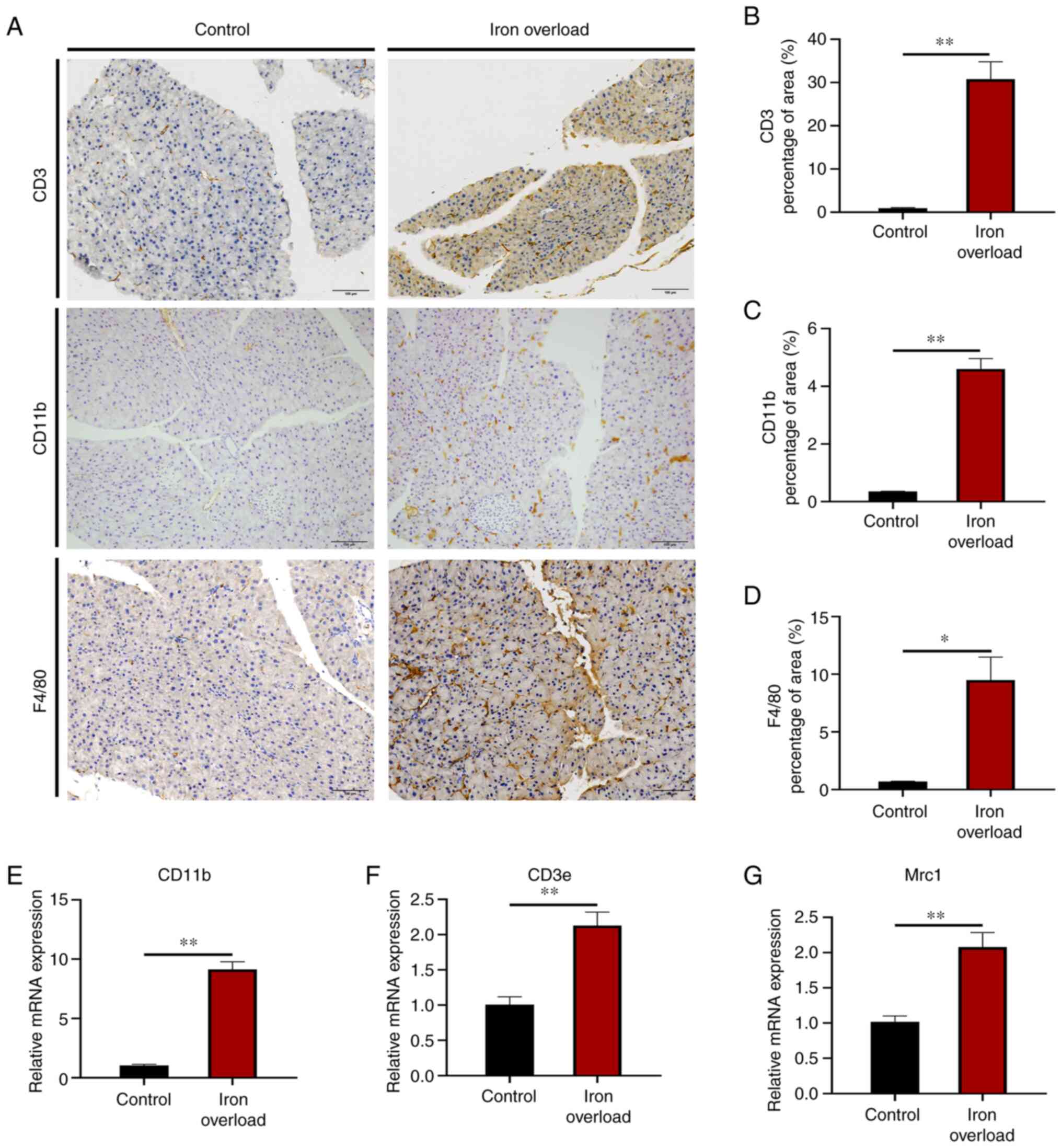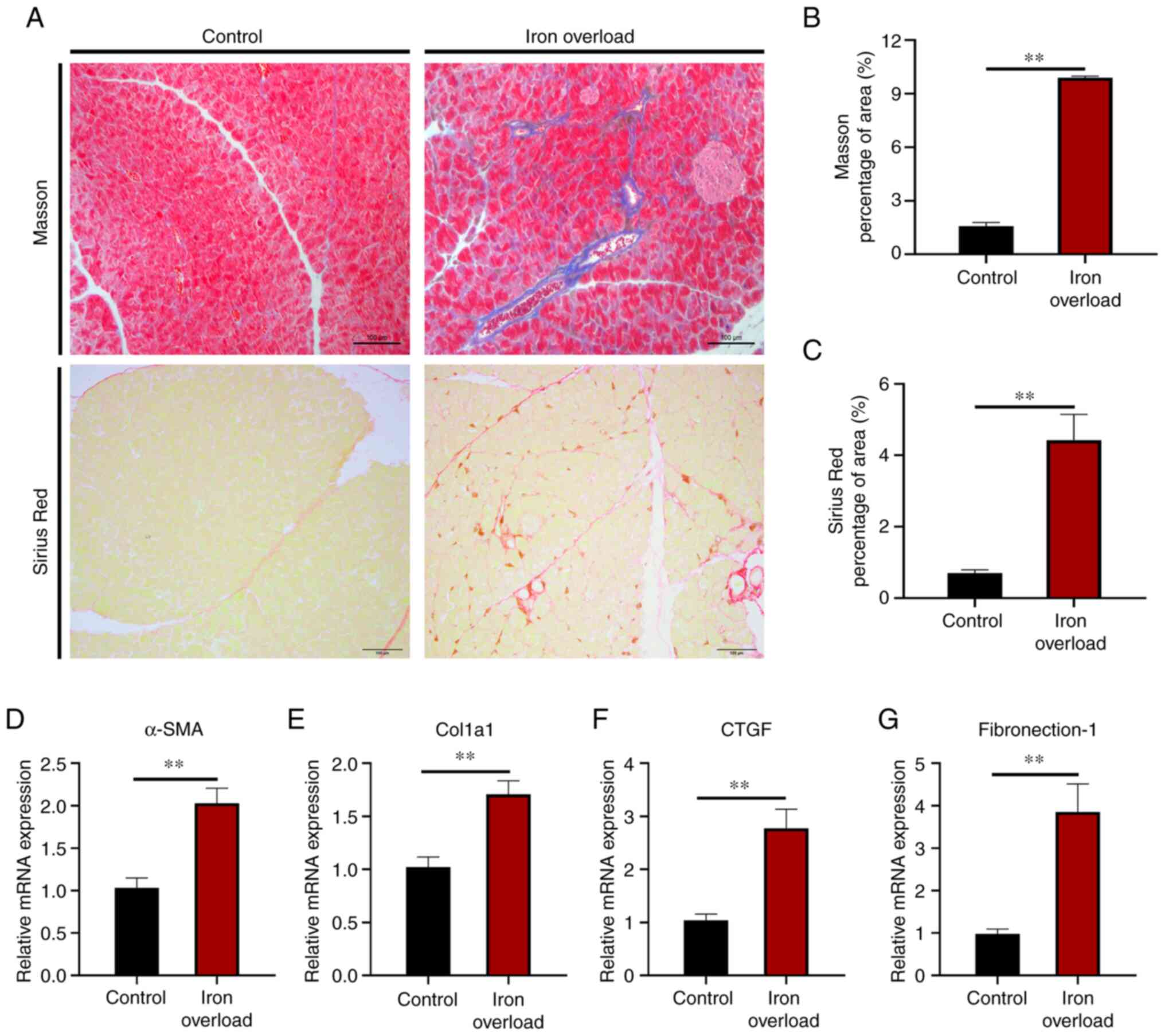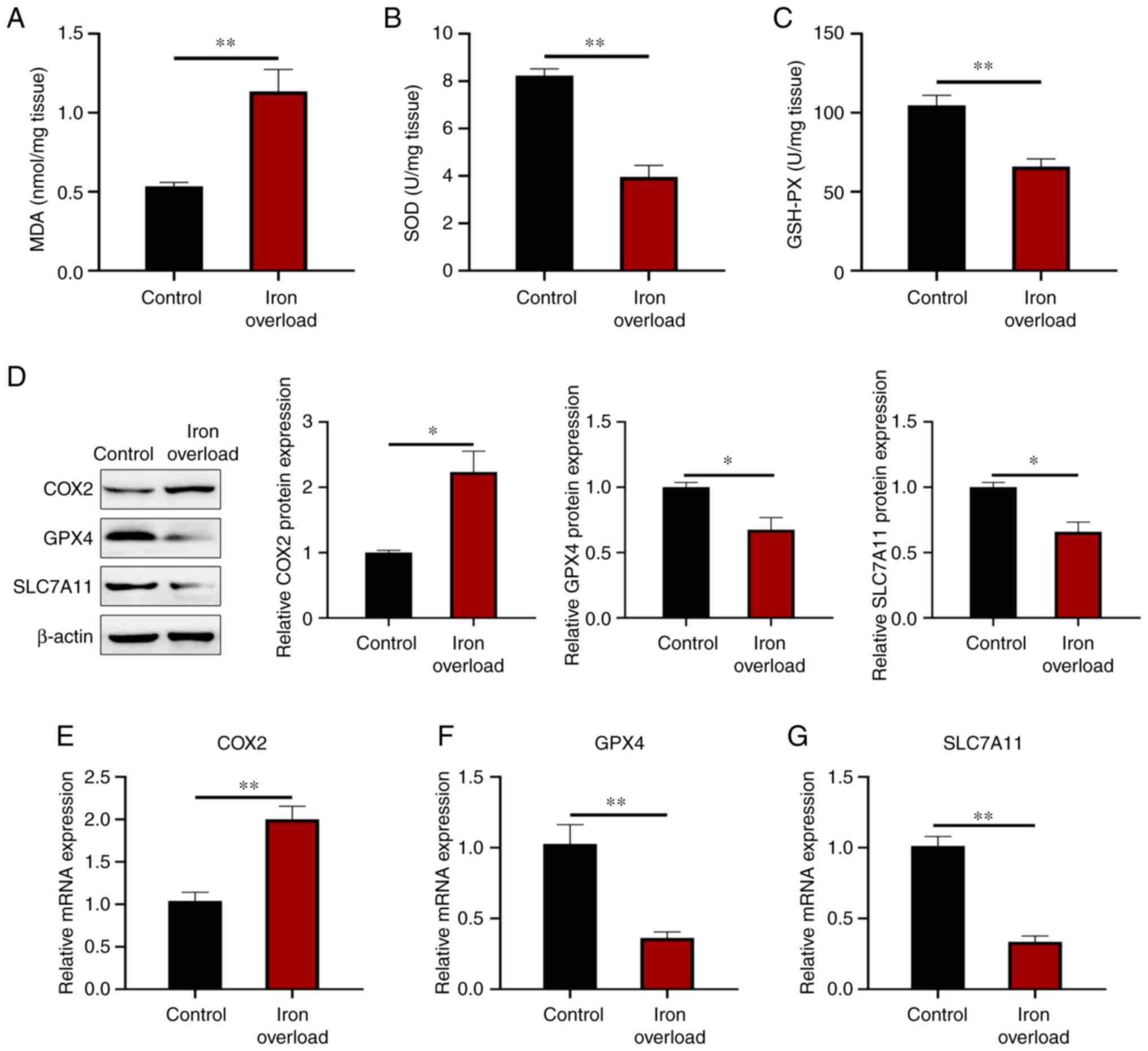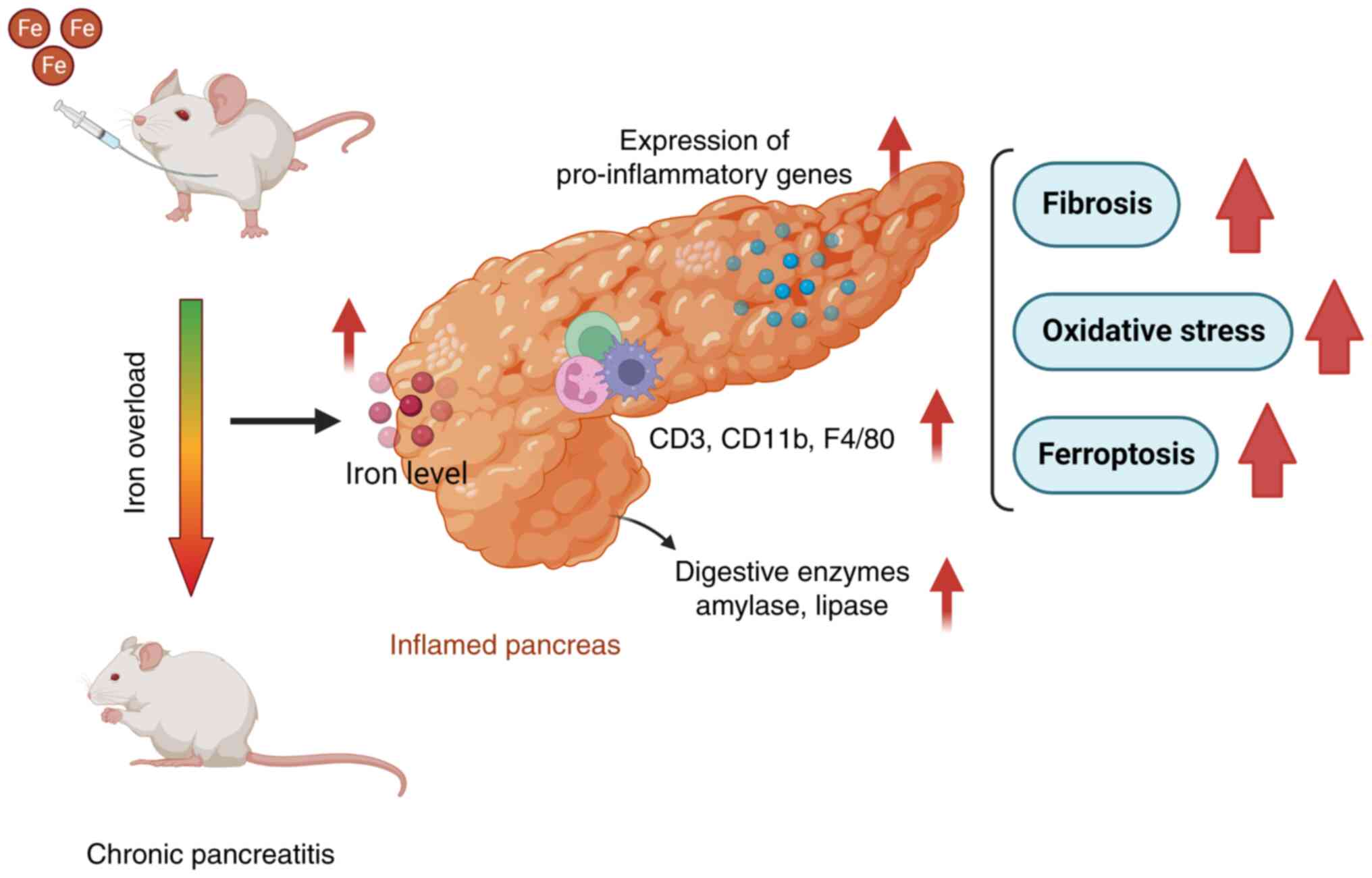|
1
|
Sarkar J, Potdar AA and Saidel GM:
Whole-body iron transport and metabolism: Mechanistic, multi-scale
model to improve treatment of anemia in chronic kidney disease.
PLoS Comput Biol. 14:e10060602018. View Article : Google Scholar : PubMed/NCBI
|
|
2
|
Puig S, Ramos-Alonso L, Romero AM and
Martinez-Pastor MT: The elemental role of iron in DNA synthesis and
repair. Metallomics. 9:1483–1500. 2017. View Article : Google Scholar : PubMed/NCBI
|
|
3
|
Ganz T and Nemeth E: Iron homeostasis in
host defence and inflammation. Nat Rev Immunol. 15:500–510. 2015.
View Article : Google Scholar : PubMed/NCBI
|
|
4
|
Hentze MW, Muckenthaler MU, Galy B and
Camaschella C: Two to tango: Regulation of mammalian iron
metabolism. Cell. 142:24–38. 2010. View Article : Google Scholar : PubMed/NCBI
|
|
5
|
Ganz T: Systemic iron homeostasis. Physiol
Rev. 93:1721–1741. 2013. View Article : Google Scholar : PubMed/NCBI
|
|
6
|
Fernandez RJM, Moreno-Navarrete JM and
Manco M: Iron influences on the Gut-Brain axis and development of
type 2 diabetes. Crit Rev Food Sci Nutr. 59:443–449. 2019.
View Article : Google Scholar
|
|
7
|
Zafon C, Lecube A and Simo R: Iron in
obesity. An ancient micronutrient for a modern disease. Obes Rev.
11:322–328. 2010. View Article : Google Scholar
|
|
8
|
Mayneris-Perxachs J, Cardellini M, Hoyles
L, Latorre J, Davato F, Moreno-Navarrete JM, Arnoriaga-Rodriguez M,
Serino M, Abbott J, Barton RH, et al: Iron status influences
non-alcoholic fatty liver disease in obesity through the gut
microbiome. Microbiome. 9:1042021. View Article : Google Scholar : PubMed/NCBI
|
|
9
|
Xu S: Iron and atherosclerosis: The link
revisited. Trends Mol Med. 25:659–661. 2019. View Article : Google Scholar : PubMed/NCBI
|
|
10
|
Fleming RE and Ponka P: Iron overload in
human disease. N Engl J Med. 366:348–359. 2012. View Article : Google Scholar : PubMed/NCBI
|
|
11
|
Fernandez-Real JM and Manco M: Effects of
iron overload on chronic metabolic diseases. Lancet Diabetes
Endocrinol. 2:513–526. 2014. View Article : Google Scholar : PubMed/NCBI
|
|
12
|
Brissot P, Pietrangelo A, Adams PC, de
Graaff B, McLaren CE and Loréal O: Haemochromatosis. Nat Rev Dis
Primers. 4:180162018. View Article : Google Scholar : PubMed/NCBI
|
|
13
|
Bottomley SS: Secondary iron overload
disorders. Semin Hematol. 35:77–86. 1998.PubMed/NCBI
|
|
14
|
Che J, Yang J, Zhao B, Zhang G, Wang L,
Peng S and Shang P: The effect of abnormal iron metabolism on
osteoporosis. Biol Trace Elem Res. 195:353–365. 2020. View Article : Google Scholar
|
|
15
|
Hatunic M, Finucane FM, Brennan AM, Norris
S, Pacini G and Nolan JJ: Effect of iron overload on glucose
metabolism in patients with hereditary hemochromatosis. Metabolism.
59:380–384. 2010. View Article : Google Scholar
|
|
16
|
Roggero S, Quarello P, Vinciguerra T,
Longo F, Piga A and Ramenghi U: Severe iron overload in
blackfan-diamond anemia: A case-control study. Am J Hematol.
84:729–732. 2009. View Article : Google Scholar : PubMed/NCBI
|
|
17
|
Vogiatzi MG, Macklin EA, Trachtenberg FL,
Fung EB, Cheung AM, Vichinsky E, Olivieri N, Kirby M, Kwiatkowski
JL, Cunningham M, et al: Differences in the prevalence of growth,
endocrine and vitamin D abnormalities among the various
thalassaemia syndromes in North America. Br J Haematol.
146:546–556. 2009. View Article : Google Scholar : PubMed/NCBI
|
|
18
|
Berdoukas V, Nord A, Carson S, Puliyel M,
Hofstra T, Wood J and Coates TD: Tissue iron evaluation in
chronically transfused children shows significant levels of iron
loading at a very young age. Am J Hematol. 88:E283–E285. 2013.
View Article : Google Scholar : PubMed/NCBI
|
|
19
|
Lee PJ and Papachristou GI: New insights
into acute pancreatitis. Nat Rev Gastroenterol Hepatol. 16:479–496.
2019. View Article : Google Scholar : PubMed/NCBI
|
|
20
|
Lugea A, Waldron RT, Mareninova OA,
Shalbueva N, Deng N, Su HY, Thomas DD, Jones EK, Messenger SW, Yang
J, et al: Human pancreatic acinar cells: Proteomic
characterization, physiologic responses, and organellar disorders
in ex vivo pancreatitis. Am J Pathol. 187:2726–2743. 2017.
View Article : Google Scholar : PubMed/NCBI
|
|
21
|
Singh VK, Yadav D and Garg PK: Diagnosis
and management of chronic pancreatitis: A review:. JAMA.
322:2422–2434. 2019. View Article : Google Scholar : PubMed/NCBI
|
|
22
|
Whitcomb DC, Frulloni L, Garg P, Greer JB,
Schneider A, Yadav D and Shimosegawa T: Chronic pancreatitis: An
international draft consensus proposal for a new mechanistic
definition. Pancreatology. 16:218–224. 2016. View Article : Google Scholar : PubMed/NCBI
|
|
23
|
Kimita W and Petrov MS: Iron metabolism
and the exocrine pancreas. Clin Chim Acta. 511:167–176. 2020.
View Article : Google Scholar : PubMed/NCBI
|
|
24
|
Lunova M, Schwarz P, Nuraldeen R, Levada
K, Kuscuoglu D, Stützle M, Spasić MV, Haybaeck J, Ruchala P, Jirsa
M, et al: Hepcidin knockout mice spontaneously develop chronic
pancreatitis owing to cytoplasmic iron overload in acinar cells. J
Pathol. 241:104–114. 2017. View Article : Google Scholar
|
|
25
|
Pauk M, Kufner V, Rumenovic V, Dumic-Cule
I, Farkas V, Milosevic M, Bordukalo-Niksic T and Vukicevic S: Iron
overload in aging Bmp6(/) mice induces exocrine pancreatic injury
and fibrosis due to acinar cell loss. Int J Mol Med. 47:602021.
View Article : Google Scholar
|
|
26
|
Pelucchi S, Ravasi G and Piperno A:
Ceruloplasmin variants might have different effects in different
iron overload disorders. J Hepatol. 75:1003–1004. 2021. View Article : Google Scholar : PubMed/NCBI
|
|
27
|
Ganz T: Hepcidin and iron regulation, 10
years later. Blood. 117:4425–4433. 2011. View Article : Google Scholar : PubMed/NCBI
|
|
28
|
Yildirim M, Kaplan M, Duzenli T, Tanoglu
A, Kucukodaci Z, Tastan YO, Guney BC and Serindag Z: Pentoxifylline
has favorable preventive effects on experimental chronic
pancreatitis model. Scand J Gastroenterol. 55:236–241. 2020.
View Article : Google Scholar : PubMed/NCBI
|
|
29
|
Livak KJ and Schmittgen TD: Analysis of
relative gene expression data using real-time quantitative PCR and
the 2(-Delta Delta C(T)) method. Methods. 25:402–408. 2001.
View Article : Google Scholar
|
|
30
|
Ma W, Jia L, Xiong Q and Du H: Iron
overload protects from obesity by ferroptosis. Foods. 10:17872021.
View Article : Google Scholar : PubMed/NCBI
|
|
31
|
Xiong H, Zhang C, Han L, Xu T, Saeed K,
Han J, Liu J, Klaassen CD, Gonzalez FJ, Lu Y and Zhang Y:
Suppressed farnesoid X receptor by iron overload in mice and humans
potentiates iron-induced hepatotoxicity. Hepatology. 76:387–403.
2021. View Article : Google Scholar : PubMed/NCBI
|
|
32
|
Zhang DL, Hughes RM, Ollivierre-Wilson H,
Ghosh MC and Rouault TA: A ferroportin transcript that lacks an
iron-responsive element enables duodenal and erythroid precursor
cells to evade translational repression. Cell Metab. 9:461–473.
2009. View Article : Google Scholar : PubMed/NCBI
|
|
33
|
Petrillo S, Manco M, Altruda F, Fagoonee S
and Tolosano E: Liver sinusoidal endothelial cells at the crossroad
of iron overload and liver fibrosis. Antioxid Redox Signal.
35:474–486. 2021. View Article : Google Scholar
|
|
34
|
Martin D, Nay K, Robin F, Rebillard A,
Orfila L, Martin B, Leroyer P, Guggenbuhl P, Dufresne S, Noirez P,
et al: Oxidative and glycolytic skeletal muscles deploy protective
mechanisms to avoid atrophy under pathophysiological iron overload.
J Cachexia Sarcopenia Muscle. 13:1250–1261. 2022. View Article : Google Scholar : PubMed/NCBI
|
|
35
|
Lohr JM, Dominguez-Munoz E, Rosendahl J,
Besselink M, Mayerle J, Lerch MM, Haas S, Akisik F, Kartalis N,
Iglesias-Garcia J, et al: United European gastroenterology
evidence-based guidelines for the diagnosis and therapy of chronic
pancreatitis (HaPanEU). United European Gastroenterol J. 5:153–199.
2017. View Article : Google Scholar : PubMed/NCBI
|
|
36
|
Beyer G, Habtezion A, Werner J, Lerch MM
and Mayerle J: Chronic pancreatitis. Lancet. 396:499–512. 2020.
View Article : Google Scholar : PubMed/NCBI
|
|
37
|
Kleeff J, Whitcomb DC, Shimosegawa T,
Esposito I, Lerch MM, Gress T, Mayerle J, Drewes AM, Rebours V,
Akisik F, et al: Chronic pancreatitis. Nat Rev Dis Primers.
3:170602017. View Article : Google Scholar : PubMed/NCBI
|
|
38
|
Manohar M, Verma AK, Venkateshaiah SU,
Sanders NL and Mishra A: Pathogenic mechanisms of pancreatitis.
World J Gastrointest Pharmacol Ther. 8:10–25. 2017. View Article : Google Scholar : PubMed/NCBI
|
|
39
|
Xue J, Sharma V and Habtezion A: Immune
cells and immune-based therapy in pancreatitis. Immunol Res.
58:378–386. 2014. View Article : Google Scholar : PubMed/NCBI
|
|
40
|
Kolaczkowska E and Kubes P: Neutrophil
recruitment and function in health and inflammation. Nat Rev
Immunol. 13:159–175. 2013. View Article : Google Scholar : PubMed/NCBI
|
|
41
|
Grunwald B, Harant V, Schaten S,
Fruhschutz M, Spallek R, Hochst B, Stutzer K, Berchtold S, Erkan M,
Prokopchuk O, et al: Pancreatic premalignant lesions secrete tissue
inhibitor of metalloproteinases-1, which activates hepatic stellate
cells via CD63 signaling to create a premetastatic niche in the
liver. Gastroenterology. 151:1011–1024.e1017. 2016. View Article : Google Scholar
|
|
42
|
Chin AC and Parkos CA: Neutrophil
transepithelial migration and epithelial barrier function in IBD:
potential targets for inhibiting neutrophil trafficking. Ann N Y
Acad Sci. 1072:276–287. 2006. View Article : Google Scholar : PubMed/NCBI
|
|
43
|
Dai E, Han L, Liu J, Xie Y, Zeh HJ, Kang
R, Bai L and Tang D: Ferroptotic damage promotes pancreatic
tumorigenesis through a TMEM173/STING -dependent DNA sensor
pathway. Nat Commun. 11:63392020. View Article : Google Scholar
|
|
44
|
Han L, Ma J, Duan W, Zhang L, Yu S, Xu Q,
Lei J, Li X, Wang Z, Wu Z, et al: Pancreatic stellate cells
contribute pancreatic cancer pain via activation of sHH signaling
pathway. Oncotarget. 7:18146–18158. 2016. View Article : Google Scholar : PubMed/NCBI
|
|
45
|
Kirkegård J, Mortensen FV and
Cronin-Fenton D: Chronic pancreatitis and pancreatic cancer risk: A
systematic review and meta-analysis. Am J Gastroenterol.
112:1366–1372. 2017. View Article : Google Scholar : PubMed/NCBI
|
|
46
|
Chen B, Li J, Fellows GF, Sun Z and Wang
R: Maintaining human fetal pancreatic stellate cell function and
proliferation require beta1 integrin and collagen I matrix
interactions. Oncotarget. 6:14045–14059. 2015. View Article : Google Scholar : PubMed/NCBI
|
|
47
|
Tang D and Kroemer G: Ferroptosis. Curr
Biol. 30:R1292–R1297. 2020. View Article : Google Scholar : PubMed/NCBI
|
|
48
|
Dixon SJ, Lemberg KM, Lamprecht MR, Skouta
R, Zaitsev EM, Gleason CE, Patel DN, Bauer AJ, Cantley AM, Yang WS,
et al: Ferroptosis: An iron-dependent form of nonapoptotic cell
death. Cell. 149:1060–1072. 2012. View Article : Google Scholar : PubMed/NCBI
|
|
49
|
Xie Y, Hou W, Song X, Yu Y, Huang J, Sun
X, Kang R and Tang D: Ferroptosis: Process and function. Cell Death
Differ. 23:369–379. 2016. View Article : Google Scholar : PubMed/NCBI
|
|
50
|
Wang C, Zheng L, Liu S, Guo X, Qu Y, Gao
M, Cui X and Yang Y: A novel acidic polysaccharide from the residue
of Panax notoginseng and its hepatoprotective effect on alcoholic
liver damage in mice. Int J Biol Macromol. 149:1084–1097. 2020.
View Article : Google Scholar : PubMed/NCBI
|
|
51
|
Ayala A, Muñoz MF and Argüelles S: Lipid
peroxidation: Production, metabolism, and signaling mechanisms of
malondialdehyde and 4-hydroxy-2-nonenal. Oxid Med Cell Longev.
2014:3604382014. View Article : Google Scholar : PubMed/NCBI
|
|
52
|
Jové M, Mota-Martorell N, Pradas I,
Martín-Gari M, Ayala V and Pamplona R: The advanced lipoxidation
end-product malondialdehyde-lysine in aging and longevity.
Antioxidants (Basel). 9:11322020. View Article : Google Scholar : PubMed/NCBI
|
|
53
|
Tsikas D: Assessment of lipid peroxidation
by measuring malondialdehyde (MDA) and relatives in biological
samples: Analytical and biological challenges. Anal Biochem.
524:13–30. 2017. View Article : Google Scholar
|
|
54
|
Olsvik PA, Kristensen T, Waagbø R,
Rosseland BO, Tollefsen KE, Baeverfjord G and Berntssen MHG: MRNA
expression of antioxidant enzymes (SOD, CAT and GSH-Px) and lipid
peroxidative stress in liver of Atlantic salmon (Salmo salar)
exposed to hyperoxic water during smoltification. Comp Biochem
Physiol C Toxicol Pharmaco. 141:314–323. 2005. View Article : Google Scholar
|
|
55
|
Sefi M, Fetoui H, Lachkar N, Tahraoui A,
Lyoussi B, Boudawara T and Zeghal N: Centaurium erythrea
(Gentianaceae) leaf extract alleviates streptozotocin-induced
oxidative stress and β-cell damage in rat pancreas. J
Ethnopharmacol. 135:243–250. 2011. View Article : Google Scholar : PubMed/NCBI
|
|
56
|
Dolma S, Lessnick SL, Hahn WC and
Stockwell BR: Identification of genotype-selective antitumor agents
using synthetic lethal chemical screening in engineered human tumor
cells. Cancer Cell. 3:285–296. 2003. View Article : Google Scholar : PubMed/NCBI
|
|
57
|
Forcina GC and Dixon SJ: GPX4 at the
crossroads of lipid homeostasis and ferroptosis. Proteomics.
19:e18003112019. View Article : Google Scholar : PubMed/NCBI
|
|
58
|
Yao W, Qiu HM, Cheong KL and Zhong S:
Advances in anti-cancer effects and underlying mechanisms of marine
algae polysaccharides. Int J Biol Macromol. 221:472–485. 2002.
View Article : Google Scholar
|
|
59
|
Xia Y, Sun X, Luo Y and Stary CM:
Ferroptosis contributes to isoflurane neurotoxicity. Front Mol
Neurosci. 11:4862018. View Article : Google Scholar
|
|
60
|
Belavgeni A, Meyer C, Stumpf J, Hugo C and
Linkermann A: Ferroptosis and necroptosis in the kidney. Cell Chem
Biol. 27:448–462. 2020. View Article : Google Scholar : PubMed/NCBI
|
|
61
|
Yamada N, Karasawa T, Kimura H, Watanabe
S, Komada T, Kamata R, Sampilvanjil A, Ito J, Nakagawa K, Kuwata H,
et al: Ferroptosis driven by radical oxidation of n-6
polyunsaturated fatty acids mediates acetaminophen-induced acute
liver failure. Cell Death Dis. 11:1442020. View Article : Google Scholar : PubMed/NCBI
|
|
62
|
Fan R, Sui J, Dong X, Jing B and Gao Z:
Wedelolactone alleviates acute pancreatitis and associated lung
injury via GPX4 mediated suppression of pyroptosis and ferroptosis.
Free Radic Biol Med. 173:29–40. 2021. View Article : Google Scholar : PubMed/NCBI
|
|
63
|
Ma D, Li C, Jiang P, Jiang Y, Wang J and
Zhang D: Inhibition of ferroptosis attenuates acute kidney injury
in rats with severe acute pancreatitis. Dig Dis Sci. 66:483–492.
2021. View Article : Google Scholar
|















